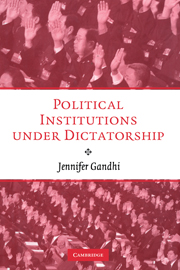Book contents
- Frontmatter
- Contents
- List of Tables and Figures
- Acknowledgments
- Introduction
- 1 The World of Dictatorial Institutions
- 2 Three Illustrative Cases
- 3 Use of Institutions to Co-opt
- 4 Institutions and Policies under Dictatorship
- 5 Institutions and Outcomes under Dictatorship
- 6 Institutions and the Survival of Dictators
- 7 Conclusion
- 8 Codebook of Variables
- Bibliography
- Author Index
- Subject Index
7 - Conclusion
Published online by Cambridge University Press: 25 July 2009
- Frontmatter
- Contents
- List of Tables and Figures
- Acknowledgments
- Introduction
- 1 The World of Dictatorial Institutions
- 2 Three Illustrative Cases
- 3 Use of Institutions to Co-opt
- 4 Institutions and Policies under Dictatorship
- 5 Institutions and Outcomes under Dictatorship
- 6 Institutions and the Survival of Dictators
- 7 Conclusion
- 8 Codebook of Variables
- Bibliography
- Author Index
- Subject Index
Summary
If parties do not compete and legislatures do not legislate, then what do these institutions do under dictatorship? This question naturally emerges if we adopt the typical view of dictatorial institutions as mere “window-dressing.” Yet this understanding of nondemocratic legislatures and parties makes little sense in light of neo-institutionalist approaches that pervade the study of other political structures and events. For one, we think that institutions, in general, are not randomly generated phenomena but rather are purposely constructed to further the goals of political actors, whether they are to solve particular problems that prevent the fruition of more efficient outcomes, to solidify distributional power, to survive in office, or to achieve whatever else. Actors use institutions to realize their goals but are constrained by the types of action available to them and by the goals and actions of others. As a result, institutions are the product of strategic behavior on the part of political actors. But this standard notion of institutions runs counter to the idea that dictatorial institutions are “window dressing.” If assemblies and parties are mere ornamentation under dictatorship, then what explains the variation in the presence and absence of these institutions? Are we to assume that such variation is determined only by the capriciousness of individual leaders rather than by the strategic logic that governs the functioning of other types of institutions?
- Type
- Chapter
- Information
- Political Institutions under Dictatorship , pp. 180 - 188Publisher: Cambridge University PressPrint publication year: 2008

